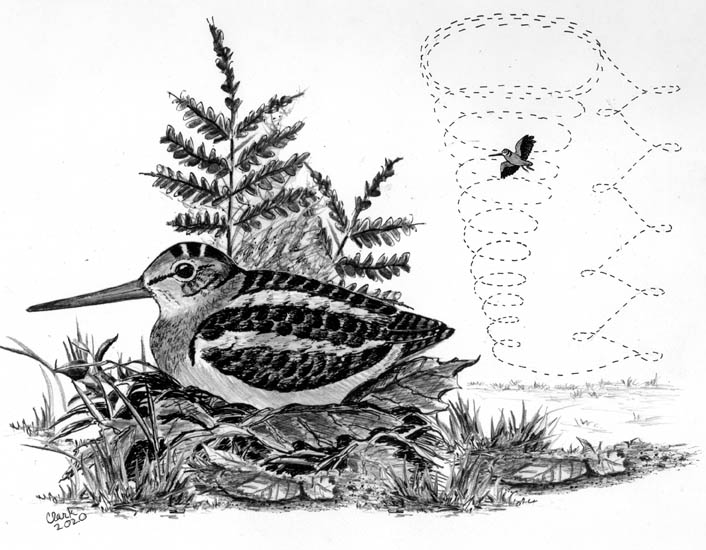
Dear Bird Folks,
I’ve decided this would be the year I would try to see some American Woodcocks and their famous spring “sky dance.” Do you know of any secret places where I should look for them?
– Paul, Dennis, MA
No way, Dennis,
I’m not telling you about my secret woodcock watching sites. What do you take me for, an idiot? Wait! Your name is Paul, not Dennis. Oops. Maybe I am an idiot after all. Fine, since I messed up, I’ll tell you my secret woodcock spots, but you can’t tell anyone else. Promise? Okay, good.
As weird as that opening paragraph was, it’s nothing compared to the American Woodcock. This is one freaky bird. To begin with, woodcocks are considered to be shorebirds, but they never go near the beach (and no, it’s not because of sharks). Instead, woodcocks prefer to spend their days poking around in damp woodlands. And while shorebirds tend to be slender and fit, woodcocks are chubbettes, looking like they’ve spent too much time eating pizza and playing video games. They have huge eyes, a short tail, no neck, a 2 1/2-inch-long beak (although the males will tell you it’s longer), and without moving their heads, they can actually see what’s going on behind them, schoolteacher style. Woodcocks also have the distinction of being the world’s slowest flying bird (five MPH). And there’s more.
The internet is filled with video clips of woodcocks walking with a bizarre back and forth rocking motion, like a drunk swaying to a song no one else can hear. Experts aren’t sure why the birds move in such a funky manner, but that doesn’t mean they don’t have a guess or two. The bulk of a woodcock’s diet consists of earthworms and it is thought this odd movement causes hidden worms to reveal themselves (probably because they’re laughing). The walk might not be totally understood, but the reason for this next peculiar behavior is clear. It’s all about love…or at least the woodcock’s version of love.
Male songbirds rely on their vocal skills to attract a mate. Other males try to impress the ladies with flashy colors. Woodpeckers, as many of us are about to find out, seek attention by drumming as loudly as possible. But all of these behaviors are nothing compared to what Mr. Woodcock does every night in the spring. Birders call it the “sky dance,” but the woodcock doesn’t dance like nobody’s watching. He’s hoping that at least one and hopefully several ladies are fixated on him. The more the merrier.
Amazingly, the woodcock’s evening show can begin as early as February and will continue every night (weather permitting) through May. Woodcocks prefer overgrown fields surrounded by moist woods. The birds feed in the woods, while the open fields are reserved for sunset (and sunrise) dancing. This is when the woodcock will leave the comfort of the thickets and fly into an open area. He immediately begins his signature “peent” call. This buzzy call has been described in many ways, but to me it sounds like a shock from a cattle prod. (Don’t ask me how I know.) After about a dozen peents, the male will take to the air and start circling above the field, gaining more altitude was he goes. To ensure that his aviation skills are noticed, his wings will also produce a high-pitched twittering sound. The bird will continue to climb until he’s nearly out of sight, at which time he’ll make cute little chirping calls from high above the ground. The chirps will continue for a minute or so, before the bird shuts the whole thing down and flutters silently back to earth like a falling leaf. He invariably lands near his original point of departure and begins the whole process over again, peents and all.
Your note reminded me that even these cold nights don’t slow the woodcocks down. So, after work last night, I went for my first woodcock walk of the season. I choose a location I had never been to before, but based on the habitat it seemed like a good choice. I was right. As soon as I arrived I could hear that weird peenting coming from across the field. I headed towards the sound, but before I arrived the bird was already in the air and starting his display. I took the opportunity to move closer to his original spot. I was hoping to see him land. Once again, I was right. He landed twenty feet from where I was standing and immediately began calling, and wasn’t at all concerned by my presence. I took out my fancy new iPhone, which somehow can take photos in the dark. There was just one problem. It took me so long to figure out how to use the thing that the bird flew off just as I snapped the photo. Rats! I was glad I saw the woodcock, but a little disappointed about missing the shot. But on the upside, I now have a great nighttime photo of an empty field. Not many people can say that.
Long Pasture Sanctuary in Barnstable, Fort Hill in Eastham and Mass Audubon in Wellfleet are all my favorite woodcock watching spots, Paul (or is it Dennis?). But any slightly overgrown field would also be a good location to try. Remember to dress warm, arrive just before sunset and listen closely for the distinctive peents. And if you have a fancy new iPhone, practice with it before you leave the house. Or if you don’t have time to practice, I’ll send you my photos of the empty field. They came out great.